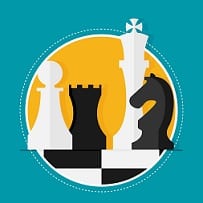
A king, just like any piece, can find itself trapped when put in such a situation that most or even all possible moves should result in a capture or at least a harmful situation.
However, the trapping of the king normally begins with the piece being pushed to the edges of the board. There is a series of mates that can be done once the king is trapped, and that is why opponents will seek to trap the king.
How To Trap A King In Chess?
Trapping a king doesn’t necessarily mean putting it in check, or checkmate with the following move, but also significantly reducing the possible moves the king may have at that moment.
For instance, a king that is sitting comfortably behind a pawn wall may find himself trapped if a bishop, for example, covers one of the sides of the wall and a pawn covers the other end.
To make it more graphic, imagine a board setup that has a black pawn triangle on f7, g6, and e6 protecting the king on g8, with a white pawn in the middle. Also, let’s add a black knight on d7, and three more black pawns on a6, b6, and h5.
On the white side, apart from the already mentioned pawn, there are four more on a3, h3, b2, and g2 apart from the king on f2 and a white bishop on f3. Trust me, there is a good reason for the pawns here.
With this formation, it seems like the king is pretty much secured by the knight and the pawn triangle, and that the match is under an apparent easy situation that doesn’t seem to be coming to such an imminent defeat for the black.
However, if black – instead of taking the white pawn in the middle of the triangle with the knight – moves h4, white can move g5 and start cornering the king.
That is because the king will now have to move all the way around the triangle and that would take an incredibly high number of moves. Seeing the bishop as the biggest threat against the king, black moves Ne5, to which white responds with Bb7.
Black saves the pawn from the bishop at a5 and white, foreseeing a check by the black knight, moves the king to safety at e3.
The black king then, avoiding an early cornering, begins to move towards circling the triangle at f8. Here, white appears to have a shot at fully cornering the king, but should the move be Bc6, the bishop may be captured by the knight.
Instead, white threatens the knight with the king on e4, which causes it to escape to c4 and leave the bishop clear to corner the king.
This still doesn’t end the match, but it becomes just a matter of time. While black will desperately seek a promotion to try and save the situation, white should get to it before – and, by promoting the pawn into a queen, the checkmate is secured.


